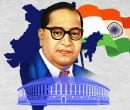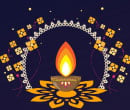
-
Customer Care 9999 091 091
- Consult Now
-
Notifications
-
Ram Navami is a pious festival celebrating the birth of Lord Rama. It is celebrated as one of the biggest festivals amongst the Hindus in India.
 Rama Navami Muhurat
Rama Navami Muhurat
 Rama Navami Muhurat
Rama Navami Muhurat
Navami Tithi Begins - 07:26 PM on Apr 05, 2025
Navami Tithi Ends - 07:22 PM on Apr 06, 2025
Navami Tithi Begins - 11:48 AM on Mar 26, 2026
Navami Tithi Ends - 10:06 AM on Mar 27, 2026
Navami Tithi Begins - 03:23 PM on Apr 14, 2027
Navami Tithi Ends - 01:20 PM on Apr 15, 2027
Navami Tithi Begins - 11:59 AM on Apr 03, 2028
Navami Tithi Ends - 10:07 AM on Apr 04, 2028
Navami Tithi Begins - 12:54 PM on Apr 22, 2029
Navami Tithi Ends - 11:29 AM on Apr 23, 2029
Navami Tithi Begins - 09:00 PM on Apr 11, 2030
Navami Tithi Ends - 09:33 PM on Apr 12, 2030
Navami Tithi Begins - 07:16 PM on Mar 31, 2031
Navami Tithi Ends - 09:34 PM on Apr 01, 2031
Navami Tithi Begins - 10:03 AM on Apr 18, 2032
Navami Tithi Ends - 12:27 PM on Apr 19, 2032
The importance of this festival is umpteen among the followers of Hinduism. The propitious day is celebrated with grandeur every year on the last day of the famous Chaitra Navaratri. It was on this day that Lord Vishnu was incarnated in his human form on the Earth as Lord Rama. He was born in the Suryavanshi kingdom in Ayodhya on the Navami Tithi in the Shukla Paksha, which is the full moon phase of the moon during the Chaitra month, as per the Hindu Panchang. The day is deemed extremely pious and is therefore celebrated with a heightened vigor across the country.
The day of Lord Rama’s birthday is celebrated with a lot of love and gratitude. People looked up to Rama as a fair and just king who taught them to live an ideal life under the principles of Ramrajya. It is for this reason that to this day, Hindus across the country pay their respects to the God on his birthday. Here is a detailed puja vidhi to help you reap the benefits of this blessed day:
Assemble the puja samagree and begin the puja by invoking Lord Ganesha
Begin the puja of Lord Rama after offering salutations to the Vighnaharta
Initiate the puja by observing dhyana or meditation
Join both hands to seek the blessings of Lord Rama and offer him your sincerest prayers
Do avahanam to Lord Rama with folded hands and respectfully place his idol or photo on a wooden platform or chowki. Cover the chowki with a clean yellow cloth before placing the idol on the asana.
Light a ghee or oil lamp to the right of the chowki
Offer gangajal to the idol’s feet
Follow this by doing an arghya
Offer a kalava, janeu, fresh clothes, haldi, kumkum, Chandan, fruits, and flowers to the Lord.
Lord Rama is said to love tulsi and panchamrit. So, offer generous amounts of these to the deity.
Chant the Vishnu Sahasranamam with devotion.
Light incense sticks and camphor
Light the tamboolam made out of coconut husk, supari, paan, banana, and dakshina.
Perform the aarti using these to conclude the puja.
In some parts of the country, this festival marks the end of the Chaitra Navratri. It is thus celebrated for ten days starting from Chaitra Saptami up until Bahula Padyami that comes in the months of March or April as per the Gregorian calendar. With the celebrations of the birth of Lord Rama, Chaitra Navratri ends, and this day coincides with the beginning of Gudi padwa as it is called in Maharashtra and the Vasanthothsava, which is the spring festival celebrated in Karnataka, Tamil Nadu, Telangana, and Andhra Pradesh.
In all the traditional scriptures and recitals enumerating the mighty personality of Lord Rama, this festival holds a special significance. Even in one of the most revered books of the Hindus, namely the Ramayana, the story of Rama’s birth sets the ball rolling towards the events that led to the victory of good over evil.
The event of Rama’s birth story is known as Vratha Katha among the learned. It was after a lot of charity and religious deeds performed by King Dashratha and his three queens that Lord Rama was born as the heir to the Suryavanshi kingdom of Ayodhya. He is believed to be a Vishnu Avatar or incarnate and is the seventh incarnation of the creator amongst the trinity of Gods. It is for this reason his birth holds so much significance among the worshippers.
This festival holds so much significance for the Hindus because it celebrates the just nature of Lord Rama and his teachings of righteousness. Many different rituals are performed on this day around the country, and we have listed down some of the most prominent ones:
Devotees around the nation hold a day-long fast that begins in the morning after sunrise and ends on the next day.
This strict fast is observed by most people without the consumption of food or water while some others eat fruits during the day. Throughout the entire day of Ram Navami 2025, devotees honor Lord Rama by narrating his tales or listening to the Ramayana.
In some places, people pay their respects to Lord Rama by performing a ceremonial wedding between him and Goddess Sita. This ritual is called Sitarama Kalyanam.
In other parts of the country, a grand procession is taken out on the streets to celebrate the day.
Bhajans and kirtans are also sung throughout the day. The ritual of singing bhajans in fact starts from the first day of Navratra up until the last day of Ram Navmi.
Lord Rama was born in the holy city of Ayodhya and the celebrations of this day are therefore grand in this city. On this day, devotees from far and wide arrive in the city to take a holy dip in the sacred waters of Sarayu, later visiting the Rama temple to celebrate the birth of Shree Ram.
The ghats in Ayodhya are decked up in thousands of diyas, illuminating the city like no other, and fairs or melas fill the people up with excitement.
Celebrations of this day differ across the country, but people celebrate it with equal fervor and enthusiasm. Here are the festivities of this day in different parts of India:
A Rath Yatra or Shobha Yatra with people dressed as Lord Rama, Goddess Sita, Hanumana, and Lord Lakshman is taken out in many parts of North India on this day.
On this sacred day, devotees take a dip in the sea and worship the Gods in the Ramanathaswamy temple in Rameshwaram.
The wedding of Lord Rama and Goddess Sita is orchestrated in many temples of South India, and it is called the Sitarama Kalyanam ceremony.
Other than this, special celebrations are observed in the following cities of the country- Ayodhya in Uttar Pradesh, Ujjain in Madhya Pradesh, Sita Samahit Sthal in Bihar, and Bhadrachalam in Telangana.
As per the scriptures, the royal king Dashratha of Ayodhya and his three queens, Kaikeyi, Kaushalya, and Sumitra, wanted kids. When they were unable to bear any children, Rishi Vshishth, the royal sage, advised them to perform the propitious Putra Kamesti Yajna to get an heir for the kingdom.
After the yajna was successfully completed, the three queens were given Kheer as prasad. All three queens soon conceived after the yajna on the ninth day of the auspicious Chaitra month. Soon after, queen Kaushalya, the eldest queen, gave birth to Lord Rama, while Bharat was born to Kaikeyi and Sumitra gave birth to Lakshman and Shatrughan.
Each individual should emulate the virtues showcased by Lord Rama and make an honest attempt to lead a virtuous life. The purity of his heart teaches us the true meaning of being divine, encouraging us to merge our human existence with his supreme self by following in his footsteps.
To know more about the auspicious mahurats of happy Ram Navami, connect with Astroyogi astrologers here!






| Date | Monday, 14 April 2025 |
| Tithi | Krishna Pratipada |
| Day | Monday |
| Paksha | Krishna-Paksha |
| Sunrise | 5:57:8 |
| Sunset | 18:46:57 |
| Moonrise | 20:7:34 |
| Nakshatra | Swati |
| Nakshtra Till | 24 : 14 : 27 |
| Yog | Vajra |
| Yog Till | 22 : 38 : 43 |
| Karan I | Kaulav |
| Surya Rashi | Pisces |
| Chandra Rashi | Libra |
| Rahu Kal | 07:33:21 to 09:09:35 |